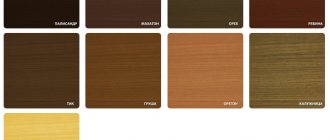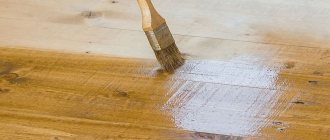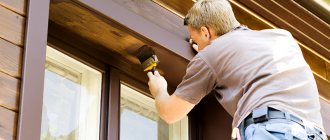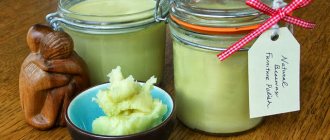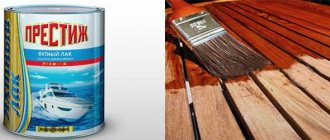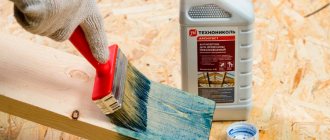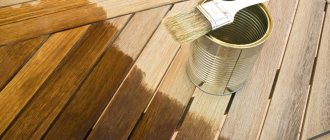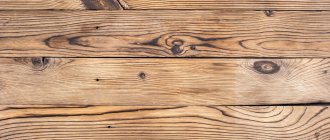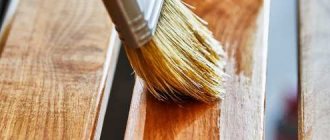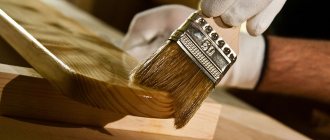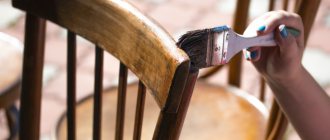Buildings and fences are erected from natural wood, furniture is made from it and finishing is performed. This is an attractive natural material with excellent quality characteristics, however, without protective compounds the array will not serve for a long period of time.
The tree is afraid of temperature changes, moisture, insects and fire. Varnishes will provide protection to the material. Let's talk about how to choose the right composition for wood, what is the difference between varnishes, and what selection criteria should be taken into account when purchasing.
Types of varnishes for wood
Wood varnishes come in different varieties, and they perform correspondingly different functions. Which one is used for what?
Oily
Due to natural resins, it covers the product with a thin yellow film. It is used for floor coverings and structures inside houses.
Alkyd
Very often confused with oil ones. They are similar only in the presence of resins, but alkyd ones contain synthetic components.
Thanks to alkyd varnishes, wood is highly polished, but due to the alcohol base, this composition is not moisture resistant.
Alkyd-urea
Varnish that requires a special acid-based hardener.
- After drying, it leaves a protective layer on the surface.
- But since it is mixed with a hardener before application, it becomes wear-resistant after drying.
Due to this, it is used on materials subject to constant use. Due to its strength, after drying it can be used outdoors.
Nitrocellulose (Cellulose Ether)
Thanks to its complex composition, the varnish is completely transparent, but with excellent protective properties. It is used for surfaces and products that are constantly indoors.
Polyester
Even the name speaks of a multi-component composition. Once dry, it forms a thick, hard surface layer. It is difficult for water to break through such protection, so it performs well outside buildings.
Polyurethane
We can say about it that it does not wear out and does not wear out. That is why it is used for finishing surfaces in areas with high traffic.
Water-based polyurethane
The "youngest" one. Just like polyurethane, it has high protection against abrasion, but is environmentally friendly. If the surface is treated for strength before varnishing, the service life of the product will increase.
Specifications
More detailed technical characteristics of wood varnishes can be found in the table below.
| Varnish type for wood | Compound | Drying time | Application |
| Oil | Condensed drying or natural oils | 24–72 hours | Coating of furniture and other wooden products, excluding floors |
| Smolyanoy | Artificial and natural resins | 24 – 72 hours | Use similar to oil formulations |
| Acrylic | Acrylic dispersion, plasticizer, water base | 2–3 hours | Finishing of floors, reconstruction of wood products, external and internal work, including wet wood |
| Epoxy | Epoxy resin | 8–12 hours | Coating surfaces experiencing increased loads (wooden floors, doors, parquet) |
| Nitrolac | Cellulose nitrate, plasticizer, solvent, resins | 20–50 minutes | Musical instruments, pencils |
| Alkyd | Solvent, drier, alkyd resin | up to 48 hours | Furniture, parquet, floating floors |
| Alcoholic | Resin, ethyl alcohol | 20–30 minutes | Musical instruments, furniture |
| Polyester | Polyester resin | 3–6 hours | Surfaces that require a thick glossy film (for example, musical instruments) |
| Alkyd-urea | Urea, alkyd resin | From several hours to several days | Any types of wood coverings |
| Acrylic-urethane | Urethane, solvent, acrylic dispersion | 1–2 hours | Interior work (parquet, walls and floors of wooden houses or baths) |
| Alkyd-urethane (yacht) | Urethane, solvent, alkyd resin | 6–12 hours | Coating of ship surfaces |
| Polyurethane | Resins and hardener | 14–20 days | Coating of garden buildings, parquet, external and internal walls of wooden buildings, sea yachts |
Recommendations for using varnish
To obtain a more lasting effect from the varnish, you need to take into account several nuances:
- Sand the surface of the wood.
- All old compounds must be cleaned from the surface.
- There should be no dust or debris left on the surface.
- Prime the material.
- Only after careful preparation can varnish be applied.
But applying varnish also has its own characteristics:
- When applied with a brush, even hard-to-reach surfaces are covered, but streaks may remain if you do not choose a brush with loose bristles at the end.
- Smooth elements can be processed with a roller, but the fibers should not exceed 5 millimeters in length.
- When using a spray bottle, the product is coated evenly with minimal consumption of product, but if there are small parts, droplets may form.
Features of MDF varnishing
When finishing furniture and doors, varnish is used to give products a more interesting color and protect them from damage. MDF fiberboards differ from natural wood in structure, so a two-component varnish is suitable for processing them. With its help, it is possible to give products an unusual effect and make the material resistant to temperature and moisture.
Requirements that varnish for coating MDF panels must meet:
- two-component, odorless product;
- moisture resistance and heat resistance;
- high antiseptic characteristics;
- optimal drying time – up to 72 hours;
- operating temperature of use - +5+25°C;
- content of volatile substances within 20%;
- material consumption rate – up to 0.5 kg per 1 m2.
Preparation and varnishing of MDF includes the following steps:
- Before varnishing, a primer is applied to the MDF panels and the damaged areas are treated with putty.
- The product is sanded with fine-grained sandpaper and a second layer of primer is applied.
- They are varnished, difficult areas are treated with a brush, and then the main part of the furniture facade, panel or door is varnished.
Since the varnish for MDF is based on two components, before work they are combined and stirred with a construction mixer, and the mixture must be filtered. The prepared working solution must be used within three hours. Can it be used later? Not recommended.
How to choose wood varnish
How not to get confused in the huge selection of materials? Professionals advise taking into account several main factors:
- Choose a well-known manufacturer that has been working in this market for a long time, about which you can read reviews.
- Be sure to consider what exactly you need the varnish for. This information is indicated on the packaging.
- There are tools for working indoors, and there are tools for working outside them. This must also be taken into account when purchasing varnish, because... the classification takes into account both resistance indicators and harm to humans.
- Additionally, consider what the varnish solvent is. This will help eliminate defects or dilute thickened varnish.
- A very important indicator is drying time. It depends on how long it will take to use the product or room.
- Depending on the location of the surfaces to be coated, the degree of thermal protection must also be taken into account.
- Most often, substances that protect the surface from ultraviolet are added to varnishes for outdoor use. Take this indicator into account if you do not want the surface to quickly darken or crack.
- When choosing a varnish, keep in mind that the one consisting of 1 component is already ready for use, but it is more expensive, and the one consisting of 2 components requires pre-mixing with a hardener, but it is cheaper.
- There are varnishes of various colors. If you want to preserve the visual structure of the wood, choose a coating that does not have a color pigment.
- It is necessary to take into account the minimum and maximum flow rates. Without them, it is impossible to calculate how much varnish is needed.
- Think in advance what kind of finish you want to get.
- To calculate this, keep in mind that the weight is approximately twice the volume.
- It happens that the manufacturer clearly indicates how to apply its products. Please review this information before purchasing to purchase the missing tool if necessary.
- The content of hazardous substances must be taken into account if work is carried out in houses with permanent residents. If no one will live in the house until the varnish has completely dried, then this parameter can be ignored.
- There are many varnishes that do not require careful surface preparation, but there are also those that will not stick to wood without a primer. Be sure to read the information on the preparatory work on the packaging.
These are not tricky selection criteria. Of course, they are not universal and everyone decides for themselves what is more important to them. But the more carefully you approach the choice of varnish, the better the end result will be.
Operating Information
It is imperative to take such nuances into account.
- Surface hardness – this includes wear resistance and impact strength characteristics. High coefficients of these characteristics indicate the possibility of long-term use of parquet flooring.
- Gloss level – there are 3 types of varnishes for parquet flooring:
- matte, semi-matte and silky-matte – no more than 25%. As a rule, this parameter is marked in the name. Examples are: Tikkurila Parketti-Assa 20, Synteko Pro 20.
- half glossy – add about 50% shine;
- glossy – add up to 90%.
- Resistance to frost - this characteristic is noted in the instructions in the “Storage” section.
It is a pity that most consumers do not attach importance to this data, which is in vain. Varnish whose storage temperature is above +5 ° C, after standing in the cold for some time, will simply begin to curl. It is impossible to use such varnish, and the only thing left is to throw it away. The verification is quite simple: ask the seller to open a jar of products. Inhomogeneity of the composition, flakes that pop up when shaking, and other impurities indicate that the product is unsuitable for use. When choosing a varnish for parquet, you need to pay attention to whether it is glossy or matte, and whether it is resistant to low and high temperatures - The resulting color and the ability to add color - colorless, water-based compositions do not affect the tint characteristics of the wood. If there is a solvent in the composition, it slightly makes the color richer, and a familiar yellowish color appears. If you need the wood to acquire a certain color shade, then you can choose an already prepared composition or mix it yourself using a color scheme; the possibility of diluting the composition should be noted on the label.
- The approximate amount of varnish is an average value, which depends on the type of tools used and the preparedness of the wood. The most inexpensive way is to use a spatula on a coating that has undergone a priming process. Ultimately, the layer is applied thinly and evenly. Consumption varies from 80 to 150 ml for each m2 of parquet flooring.
- Drying period and acquisition of strength characteristics. Varnishes containing oils will take the longest to dry. The drying speed of varnish mixtures containing a hardener is the highest; an 8-hour period is enough to dry one layer and about 4 days to fully acquire the expected strength characteristics.
Be sure to pay attention to how long it takes for a particular type of varnish to dry.
Classification by place of application
Based on the place of application, two categories can be distinguished:
- External;
- Internal.
But it can also be divided according to a narrower purpose:
- Parquet.
- Furniture.
- For street work.
What to do before painting
Painting wooden facades should be done only after some preparatory measures have been completed.
You also need to consider the following points in advance:
- All wood surfaces must be inspected for imperfections. If the latter are identified, then they need to be eliminated by repair or replacement of parts with new ones;
- carefully read the instructions before the first problems arise;
- check the surface for dryness. Also, the temperature of all materials and air should not be below 5 degrees Celsius. Air humidity should not exceed 80%;
Prepared surface of the external walls of the house for priming and further work
If the paint is oil-based, then you do not need to apply it in the evening, since the surface will be exposed to dew. When working in bright sunshine, the surface to be painted must be protected from direct sunlight (during the painting period); instead of colorless antiseptics, it is better to choose colored ones - they will better protect the facade from ultraviolet radiation; primer and paint must be the same color; If there are places on the surfaces covered with mold, then they need to be washed with a solution of “Homeenpoisto” and water in a ratio of 1 to 3. This solution is applied from the bottom up. After use, the solution is washed off with water using brush movements from top to bottom; the above-mentioned composition lightens the wood, so you need to make sure that it does not get on unpainted surfaces;
Homeenpoisto solution for removing mold from wooden surfaces
primer antiseptics are applied to new logs and boards as quickly as possible
If painting work is planned to be carried out only for the next season, then you can protect the tree from biological influences using two layers of Valtti-Pohjuste antiseptic; if glazing antiseptics are used, it is important to remember that the final color will also be influenced by the type of wood, as well as the number of layers applied. A test application of paint is used to check the color; antiseptics are applied along the wood fibers from edge to edge and without stopping; Mixing the paint is done once and in one container - otherwise the shades of colors may differ.
Painting wooden houses also requires observing certain things during the process:
- the ends of the wood are also treated with a primer and paint layer - this is necessary to protect them from moisture;
- the final color will be clear only after drying - therefore, when trying the paint, you should wait until it dries;
- the paint must be mixed before and after the painting process;
- For temporary storage, it is best to place the brush in a tightly tied plastic bag.
After finishing painting the facades, you should close the jar so that the lid fits completely into it. After this, the jar is turned upside down for a while. This way the lid will close more tightly.
If after completing all the work there is still paint left and no longer planned to be used, it is recommended to transfer it to a toxic waste collection site.
What is the difference between varnishes?
One of the most important differences is the protection of wood under the influence of natural factors. Due to humidity levels, the tree constantly changes its size. Varnish for outdoor use, thanks to its elastic film, prevents the wood from deteriorating due to constant changes in size.
Varnishes used indoors lack such protection, which is why their use outdoors is pointless.
Properties and chemical composition
The main purpose of varnish is to protect wood from the negative effects of external factors. Therefore, special substances are introduced into its composition to ensure such properties at a sufficient level. To obtain high water resistance, the product contains xylene, toluene or other toxic benzene compounds. It is because of them that the varnish cannot be used indoors, although as it evaporates, the coating becomes safe for the body. The main component of yacht varnish can be various polymers - alkyds (synthetic resins based on phthalic acid), urethanes, etc.
The concept of “yacht varnish” or “deck varnish” is applicable to all products that are characterized by increased weather resistance and are intended for wooden products. Materials of this group are characterized by the following properties:
- High adhesion to the base. The varnish film adheres reliably to the surface, does not peel off or crack over time.
- Strength and hardness. Thanks to these qualities, the varnish does not react to scratches, is not damaged by other types of mechanical stress and has a long service life.
- Elasticity. After drying, the material is able to move to some extent following changes in the position of the substrate. This property helps the varnish film not to crack or peel even with severe shrinkage of the wood.
- Abrasion resistance. Yacht varnish is resistant to abrasion because it has good ductility and tensile strength.
- Moisture resistance. The film repels water, protects wood from getting wet and swelling, and prevents putrefaction and mold.
- Counteracting microorganisms. Thanks to the varnish coating, the underwater part of the ships does not become overgrown with algae, fungal colonies, and other aquatic organisms do not settle on it. This helps save fuel and extend the life of the wood. This property is achieved by introducing into the composition biocides that are not washed out by water and do not dissolve in it.
- UV resistance. The varnish includes additives that absorb ultraviolet radiation and transform it into thermal energy. The composition also contains light stabilizers (amines) that bind free radicals and prevent the latter from destroying the varnish film.
Insecticides are often introduced into household products that are used to protect furniture and other household items. They prevent the appearance of flies, other insects and the proliferation of larvae in the wood.
Tricks for using varnish
Despite its apparent ease, working with varnish has its own subtleties.
Consumption calculation
The first step is to decide on the amount of paint and varnish material. To correctly calculate the required volume, several factors should be taken into account:
- Porosity of a wooden surface. The larger and deeper the pores, the more varnish is needed.
- The thickness of the varnish itself. The thicker it is, the greater the volume required. For the first layer, the composition may be diluted with an appropriate thinner.
- The smoother the surface is sanded, the less varnish will be required.
- The volume also depends on the method of application. When using a spray bottle, the composition consumption is less.
When applying one layer, a liter volume is enough for approximately 10 square meters. When planning a coating with two layers, the estimated area increases to 20 square meters.
Removing old varnish
If it is not the first time that you have varnished wood, you need to get rid of the old product. To do this correctly, you need to take into account some data:
- What was the coated wood used for?
- What layer was applied;
- What paint and varnish material was used.
The most common way to get rid of old varnish is to use chemical solvents. They are selected either according to the type of varnish, or universal ones are used.
The method of using such products is not complicated, the main thing is to follow the instructions and take precautions. The solvent is distributed over the entire surface and, after the reaction, is removed with a rubberized spatula.
If you do not want to deal with chemicals, the varnish can be removed mechanically. To do this, you can use a special scraper or a surface grinding machine.
Nuances when applying varnish
To make the wood last longer, it is recommended to cover it in two layers. The first is thin, which dries out in a few hours, and the second is thicker. The second layer can take quite a long time to dry completely.
- Varnishing is similar to painting. The excess is removed from the brush, and the composition is spread over the product. If bubbles form during the work, they are removed immediately with a brush.
- As described earlier, the speed of complete drying of the paint and varnish material depends on its properties and the number of layers applied.
- If a painted product will be varnished, then it is better to choose acrylic compounds. This way they will strengthen each other. But it should be remembered that acrylic paint itself provides excellent protection. In this regard, applying varnish after paint may only be a waste of money.
Requirements for means for external work
There are quite a lot of products available on the modern market for exterior finishing of a wooden house. The facade can be painted with paint that will completely hide the structure of the wood, it can be lined with finishing materials, but only varnish can preserve and emphasize the natural beauty of the wood. Varnish forms a dense elastic film on a wooden surface, which decorates and at the same time protects the wood.
An important criterion for choosing a varnish is its operating conditions. In this case, it will be applied to the facade of the building, which is located in the open air.
There are special requirements for products intended for exterior finishing. Varnish for exterior finishing of a log house must protect the wood from mechanical damage, negative natural and biological factors, and also have good decorative characteristics.
Requirements for paint and varnish materials for facade finishing:
Wear resistance. This indicator is especially important when varnishing external horizontal surfaces: terraces and steps. In this case, it is necessary to choose a composition with a high degree of resistance to wear and mechanical damage. A varnish with average wear resistance is suitable for covering the walls of a wooden house. UV resistance. Ultraviolet radiation is one of the main causes of fading and rapid wear of the coating. It is necessary to varnish the façade with products containing special components that increase resistance to direct exposure to the sun. Waterproof. The main enemy of wood is moisture, under the influence of which the wood begins to rot and fungus and mold appear on the surface.
Therefore, it is very important that the varnish coating creates a protective layer on the surface that repels water. Protection from insects. Wood is a breeding ground for various microorganisms and beetles, which, settling in its structure, destroy the wood from the inside
It is desirable that the varnish contains substances that protect the wood from pests.
Getting rid of varnish odor
There are people who are very sensitive to odors, especially after renovation work. To ensure that all residents of the house feel good, it is better to eliminate the residual aroma of paints and varnishes.
There are several solutions:
- Regular wiping of the varnished surface with a vinegar solution (two tablespoons of vinegar per 7 liters of water);
- Before use, you can add a couple of drops of mint or vanilla essence to the container with varnish;
- Creating a low level of humidity in the room;
- Regular and long-term ventilation of the room with varnished objects;
- Air purification with a special device.
Useful tips
- Self-adhesive film is used to protect windows from splashes. You need to remove it after application, without waiting for the paint to dry.
- Paint stains from windows can be removed with a dry cloth previously moistened with white spirit. Traces need to be removed after the paint has partially dried - the main thing is not to let the paint harden, but there is no need to remove fresh paint either, since it will begin to smudge.
- The quality of painting also depends on the choice of a good brush. To paint small details, use a pointed brush.
Painting work is not recommended to be carried out under the scorching sun
If painting a plank surface, take breaks only after finishing painting the last board. It’s better to paint everything in one go. Before finishing, it is advisable to smear the edges with weak strokes of a dry brush. When applying paint to elements of windows and doors, the problem arises that the paint will stick together. You can avoid this by painting early in the morning so that by evening the surface is dry and you can start using the doors and windows. It is advisable to lubricate the hinges with Vaseline - this will prevent difficulties with opening the next day. To prevent sand particles from the walls from getting into the paint container, pour the required amount into a separate container.
Why do bubbles appear?
There are several options for this behavior of varnish:
- High wood humidity;
- There is a lot of varnish that is not distributed during application;
- An inappropriate application method was used;
- Poor compatibility of the varnish with previously applied compounds;
- Poorly polished surface;
- If a two-component formulation is used, a poorly mixed mixture may cause bubbling;
- The previous layer has not dried;
- There is dust or dirt left on the surface.
There are different reasons. Even a seemingly trifle in the work can ruin the final result.
Plastering technology for creating decorative surfaces
There are a huge variety of styles of material application. There are complex techniques where working alone is simply unacceptable.
Complex Travertino technique
Let's talk about the most common technologies:
- "fur coat";
- "bark beetle";
- "mosaic".
They will certainly decorate the facade of your home and make it unique.
"Fur coat"
“Fur coat” is a variant of interior and exterior wall decoration with a rough surface. To do this, you do not need to look for specialized material; the effect is achieved through a unique application.
Options for applying a “fur coat”
Covering the wall is not difficult, so this option is great for DIY application. The layer turns out dense and thick, it serves as additional sound insulation for the house. For the “fur coat”, they often use not ready-made solutions, but self-made ones based on cement and sand.
Let's talk about four options for applying such a decorative layer:
- Using a roller with holes or made of fur. For this, a liquid solution is used. If it seems thick, it is diluted with water or another product. The mixture is applied to the wall with a spatula, and then it is rolled out over the surface using a roller.
- Using a spatula, apply the mixture to the wall, smooth it out, and then use a trowel to create a texture. This method is the simplest and can be used by beginners. To create the design, apply a trowel to the wall while the plaster is wet, and then quickly remove it. You will get a “fur coat”.
- You can also create a pattern using a special sprinkler. It is very convenient to work using mechanical means.
- The last option is to imitate the design using a broom. A new one is sprayed onto the applied thin smooth layer by sharp swings of a broom, previously lowered into a bucket of solution.
Creating texture using a fur roller
"Bark beetle"
Perhaps the most popular type of solution application. Externally, the surface resembles wood eaten away by beetles, hence the name.
Surface "bark beetle"
For such work, specialized ready-made solutions, as well as dry mixtures, are offered. First, a smooth layer of plaster is applied. As soon as it starts to dry out and stops shining, start rubbing it with a trowel. The design options “rain”, “lamb”, “carpet” depend on how the hand movements are made (horizontally, vertically, diagonally, in a circle).
The wall is made using the “bark beetle-rain” technique
A short video will help you decide on the technique:
Related article:
Mosaic
This option looks very impressive, and came to us from antiquity. The material contains marble, malachite, lapis lazuli chips, fractions up to 3 mm in size.
"Mosaic" option
The application technique is simple: using a grater, the mixture is pulled from one corner to another without drying out. You need to work quickly so that the joints are not visible.
Photo of protective varnish for wood
comparison table
Based on the rating compiled above, we organized the main technical parameters of varnishes and placed them in a table. With this organized information, you can track down the most suitable remedy for yourself.
| Name | Shine | The basis | Weight | Price, rub) |
| EUROTEX | semi-gloss | acrylic | 2.5 | 400 – 850 |
| TEX Pro | glossy | acrylic | 2.5 | 650 – 1 200 |
| VGT | glossy | acrylic | 3 | 350 – 700 |
| Dulux Diamond Glaze | glossy | acrylic-urethane | 0.9 | 480 – 650 |
| Tikkurila | glossy | acrylic | 2.7 | 500 – 680 |
| Parade | glossy | acrylic | 2.6 | 800 – 1 100 |
| Dulux | semi-gloss | alkyd-urethane | 2.5 | 400 – 600 |
This is interesting: How to choose a wear-resistant and moisture-resistant floor varnish - we explain carefully
Video description
See how to properly apply the repair mixture using spatulas:
If a flowable, odorless water-based floor varnish is chosen for finishing, the floors are first primed in 1-2 layers, drying each one. In general, a primer will not be superfluous for any varnish. It will make the base less permeable, improve its adhesion to the decorative composition, and reduce varnish consumption.
Conditions for performing painting work
Each coating has its own optimal conditions for application, drying and polymerization. They are indicated in the instructions. Some varnishes can be worked at an air temperature of +5 degrees, for others the minimum temperature is +15 degrees. Therefore, before choosing a varnish for parquet, you need to study the instructions.
An important indicator of the environment is the humidity of the air and the base itself. All varnishes, except those that are water-based, must be applied to a completely dry surface with air humidity not exceeding 80%.
The varnish cannot be applied to floorboards made of wood with natural moisture; they must be allowed to dry Source milano-colori.com
It is also advisable to exclude drafts while the coating dries. An exception is made for toxic acid-curing compounds.
Application rules
To apply varnish, use brushes with natural bristles, velor rollers or special applicators. Use a brush to paint corners and hard-to-reach places, and spread the product over the main surface with a roller or applicator, moving it along the fibers.
The parquet is varnished in 2 or 3 layers.
- Apply the first layer.
- Let it dry.
- Sand to remove raised wood fibers mechanically or manually with fine-grained sandpaper.
Intermediate sanding of parquet Source amazonaws.com
- Vacuum and wipe the floor with a damp cloth.
- Dry again and repeat the varnishing procedure.
Video description
How to mix and apply two-component varnishes, watch in the video:
Varnishes are classified according to the type of synthetic resins they contain, which are the base.
Acrylic
Acrylic floor varnish is odorless, quick-drying, as it is water-based. Its advantages are affordable price, ease of application, non-toxicity. But the moisture resistance and wear resistance of such compositions are low, they do not withstand abrasion and mechanical loads well, therefore they are recommended for use in dry rooms with little traffic - in bedrooms, offices, living rooms.
Advice! To prevent the water in the varnish from penetrating into the wood fibers and causing it to swell, it is advisable to prime the floor before decorative finishing with such means.
Acrylic parquet varnish Source vse-kraski.ru
Let's sum it up
You cannot use regular varnishes on outdoor products. And from this article we learned why. It is not for nothing that special compounds were created for this purpose. They have excellent characteristics and can serve in negative conditions. All that remains is to decide on the type of paintwork and buy it. And thanks to a video about each type of coating, you can easily do it yourself.
Recommended Posts
Oil paints.
Characteristics How to paint walls with water-based paint without streaks
Silver paint
Mixing colors
Coal solvent
How to choose washable paint for the kitchen
Briefly about the main thing
When choosing which parquet varnish is best for the floor in a house, bathhouse or on a terrace, you need to take into account many factors. The main ones are the mechanical load on the floor covering and the conditions under which it is used. For living rooms with a normal microclimate and low traffic, any water-based or organic-based varnishes with average wear resistance - acrylic, alkyd, urethane - are suitable. Where traffic is high, it is better to use durable polyurethane compounds. And for outdoor coatings, epoxy varnish is the best choice.
